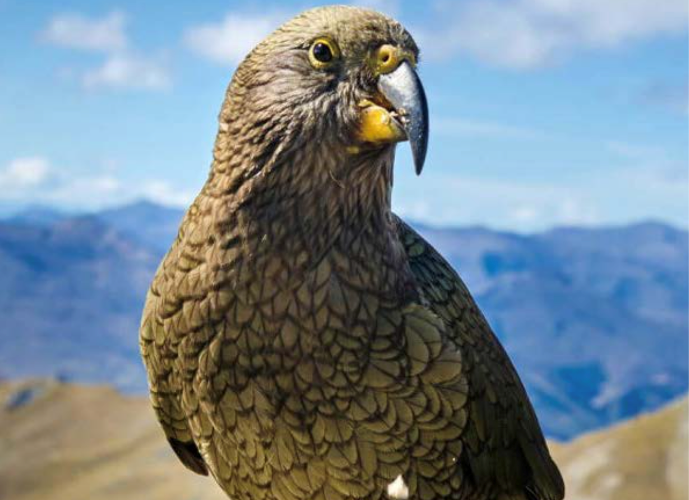
KEA- World’s only alpine parrot
Life Desk
Published:02 Jun 2021, 10:40 AM

KEA- World’s only alpine parrot
The kea is a species of large parrot in the family Nestoridae found in the forested and alpine regions of the South Island of New Zealand. About 48 cm (19 in) long, it is mostly olive-green with a brilliant orange under its wings and has a large, narrow, curved, grey-brown upper beak. The kea is the world's only alpine parrot. Its omnivorous diet includes carrion, but consists mainly of roots, leaves, berries, nectar, and insects. Now uncommon, the kea was once killed for bounty due to concerns by the sheep-farming community that it attacked livestock, especially sheep. In 1986, it received full protection under the Wildlife Act.
The kea nests in burrows or crevices among the roots of trees. Kea are known for their intelligence and curiosity, both vital to their survival in a harsh mountain environment. Kea can solve logical puzzles, such as pushing and pulling things in a certain order to get to food, and will work together to achieve a certain objective. They have been filmed preparing and using tools. The kea is a large parrot about 48 cm (19 in) long and weighs between 800 grams (1.8 lb) and 1 kilogram (2.2 lb). It has mostly olive-green plumage with a grey beak having a long, narrow, curved upper beak. The adult has dark-brown irises, and the cere, eyerings, and legs are grey. It has orange feathers on the undersides of its wings. The feathers on the sides of its face are dark olive-brown, feathers on its back and rump are orange-red, and some of the outer wing are dull-blue. It has a short, broad, bluish-green tail with a black tip. Feather shafts project at the tip of the tail and the undersides of the inner tail feathers have yellow-orange transverse stripes. The male is about 5% longer than the female, and the male's upper beak is 12–14% longer than the female's. Juveniles generally resemble adults, but have yellow eyerings and cere, an orange-yellow lower beak, and grey-yellow legs.
The kea is one of ten endemic parrot species in New Zealand. The kea ranges from lowland river valleys and coastal forests of the South Island's west coast up to alpine regions of the South Island such as Arthur's Pass and Aoraki / Mount Cook National Park. It is closely associated throughout its range with the southern beech (Nothofagus) forests in the alpine ridge. Apart from occasional vagrants, kea today are not found in the North Island. Subfossil kea bones have been found in sand dunes at Mataikona in the eastern Wairarapa, Poukawa near Hastings, and Waitomo, indicating that they ranged through lowland forest over much of the North Island until the arrival of Polynesian settlers about 750 years ago. Kea subfossils are not restricted to alpine areas, being commonly found in lowland or coastal sites in the South Island. The current distribution of kea reflects the effects of mammalian predators, including humans, which have driven them out of lowland forest into the mountains.
The total kea population was estimated at between 1,000 and 5,000 individuals in 1986, contrasting with another estimate of 15,000 birds in 1992. The kea's widespread distribution at low density across inaccessible areas prevents accurate estimates. Current estimates suggest a population of between 3000 and 7000 individuals. The kea's notorious urge to explore and manipulate makes this bird both a pest for residents and an attraction for tourists. Called "the clown of the mountains", it will investigate backpacks, boots, skis, snowboards, and even cars, often causing damage or flying off with smaller items. Kea have been kept as pets before being protected, but rarely, since they were difficult to capture and destructive when in captivity. People commonly encounter wild kea at South Island ski areas, where they are attracted by the prospect of food scraps. Their curiosity leads them to peck and carry away unguarded items of clothing, or to pry apart rubber parts of cars – to the entertainment and annoyance of human observers. They are often described as "cheeky". A kea has even been reported to have made off with a tourist's passport while he was visiting Fiordland National Park.
The Department of Conservation also suggest that the time savings resulting from a more calorie-rich diet will give kea more free time to investigate and hence damage things at campsites and car parks. The birds' naturally trusting behaviour around humans has also been indicated as a contributing factor in a number of recent incidents at popular tourist spots where kea have been purposely killed. Kea were eaten by Māori. They were believed by the Waitaha tribe to be kaitiaki (guardians).